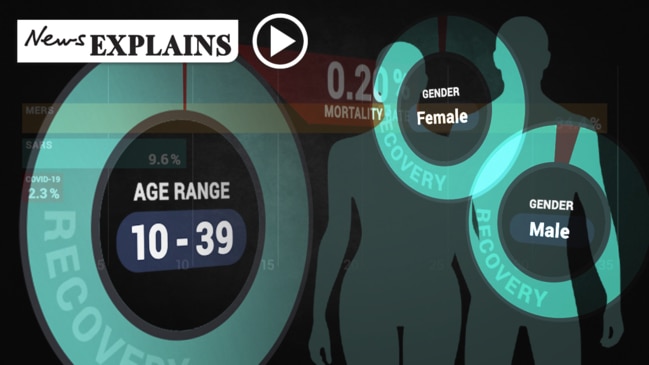New data shows how coronavirus compares with influenza
Coronavirus is more infectious and has a higher death rate than the flu, according to a new report from the World Health Organisation.

New data suggests the coronavirus is more contagious and deadly than influenza, but there’s hope it is also easier to contain.
Sydney University infectious diseases expert Professor Robert Booy told news.com.au the coronavirus in its present state spreads more easily than the flu.
On Saturday, the World Health Organisation released its report after 13 foreign experts toured five Chinese cities to study the epidemic and the country’s response.
It found the coronavirus, known as COVID-19, was “unique among human coronaviruses in its combination of high transmissibility, substantial fatal outcomes in some high-risk groups and ability to cause huge societal and economic disruption”.
This is what it means.
EASIER TO PASS ON THAN THE FLU
At this stage the coronavirus appears to be passed on by droplets, with airborne transmission unlikely to be playing a major role.
Prof Booy said someone with the flu tended to infect a further one to two people, but those with the coronavirus appeared to pass it on to others more easily, with two to three people infected.
“At the moment it seems more transmissible and more dangerous than the flu,” he told news.com.au.
However, WHO director-general Dr Tedros Adhanom Ghebreyesus told reporters in a briefing overnight the coronavirus had “unique features” that seemed to make it easier to contain.
“We have never before seen a respiratory pathogen that is capable of community transmission but which can also be contained with the right measures,” Dr Tedros said.
“If this was an influenza epidemic, we would have expected to see widespread community transmission across the globe by now, and efforts to slow it down or contain it would not be feasible.”
Canberra Hospital infectious diseases physician Professor Peter Collingnon told ABC’s RN Drive show on Monday that transmission rates were lower than expected.
Data from Shenzhen, China indicated only 2.8 per cent of those in close contact with someone with coronavirus had been infected.
In other provinces, infection rates ranged from 0.9 per cent to 4.8 per cent.
Even among household and family members, transmission rates only rose to between 3 and 10 per cent.
“That in my mind is much lower than you’d see with influenza and other viruses,” Prof Collingnon said.
RELATED: Follow the latest coronavirus update
RELATED: Australia records first human-to-human transmission

DEATH RATES ARE HIGHER THAN FLU
Prof Booy said the death rate from coronavirus was currently about 10 times higher than from influenza.
“The flu may kill up to one in 1000, but the coronavirus kills about 1 in 100,” Prof Booy said.
For those aged over 80, the odds are much worse. Their fatality rate in China was about 20 per cent.
However, Prof Collingnon believes the general mortality rate could ultimately be 10 times lower than the 2-3 per cent currently being quoted.
He pointed to data among healthcare workers in China that showed there was a 0.3 per cent death rate among the 2000 workers infected with the virus.
Interestingly, the coronavirus doesn’t seem to be affecting children for reasons that experts don’t yet understand. Only 2.4 per cent of reported coronavirus cases involved those aged 18 years and younger, and only 2.7 per cent developed severe or critical disease.
In comparison, the flu tends to be moderately severe in children.
SIMILAR SYMPTOMS
Prof Booy said coronavirus symptoms were very similar to the flu, including a runny nose, cough, sore throat and fever.
Thankfully, about 80 per cent of patients only get a mild to moderate form of the disease.
About 13.8 per cent have severe disease and 6.1 per cent are critical.
Individuals at highest risk for severe disease and death include people aged over 60 years
and those with underlying conditions such as hypertension, diabetes, cardiovascular
disease, chronic respiratory disease and cancer.
NSW Health Minister Brad Hazzard urged people to vaccinate for seasonal flu and announced measures on Monday to allow pharmacists to give injections to children as young as 10 years old.
“Last year was the longest flu season on record, and in 2017 more than 650 people in NSW died from flu-related conditions, and now we have COVID-19,” Mr Hazzard said in a statement.
“While the flu vaccine won’t combat COVID-19, it will help reduce the severity and spread of flu, which can lower a person’s immunity and make them susceptible to other illnesses.
“By allowing pharmacists to administer privately purchased flu vaccines to people aged 10 years and over, families now have more choice when booking in for a flu jab.”
Mr Hazzard said certain groups in particular should get the flu vaccine, including those aged over 65 and under the age of five, pregnant women, and perhaps those who have had other respiratory issues such as asthma.
Many of these are eligible for free vaccines.




